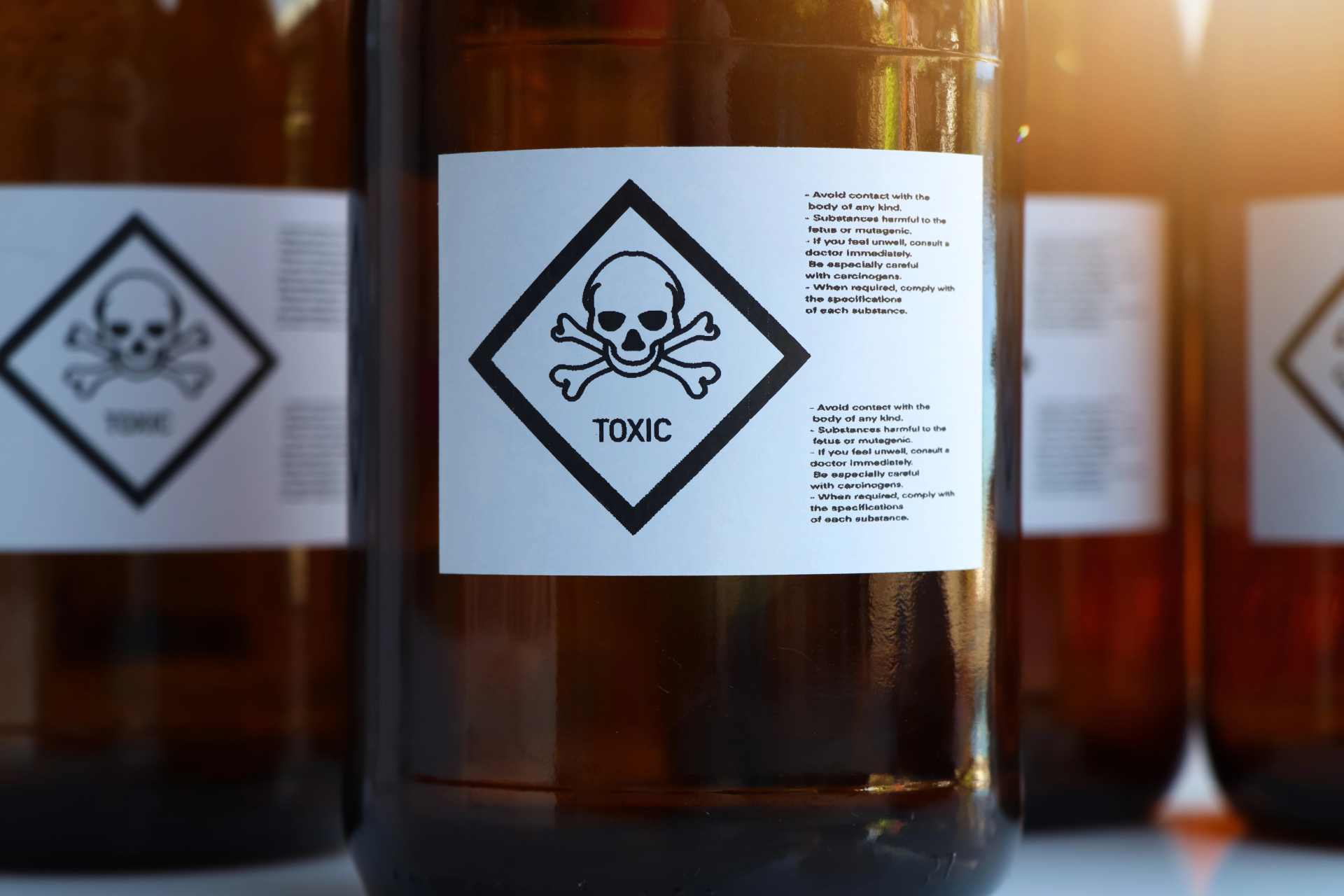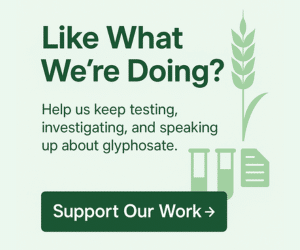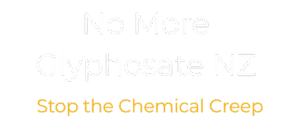We’re expected to know what’s in our food — even biscuits come with full disclosure. So why do glyphosate-based weedkillers get an exemption?
Last time we pointed out something that often slips under the radar: glyphosate itself — the so-called “active ingredient” in Roundup — is officially classified as a Hazardous Substance under New Zealand law. That means, by definition, it poses risks to health and the environment.
But here’s the twist. Roundup isn’t just glyphosate. Like most pesticides, it’s a chemical cocktail — a blend of co-formulants designed to make glyphosate stick, spread, and penetrate. And those extra ingredients? They’re hidden behind a wall of “commercial confidentiality,” treated like a patented recipe.
It’s a striking double standard. Food manufacturers are legally required to list every ingredient on a packet of biscuits, even if they disguise them behind numbers and industry codes. Yet the chemicals in Roundup — a product sprayed directly onto food crops — are kept secret. Supermarkets don’t label them. Regulators don’t disclose them. And because we don’t know what’s in the mix, our independent food testing can only ever look for glyphosate. Which raises the uncomfortable question: what else is ending up in our food supply, unseen and unmeasured?
Europe Demands Full Pesticide Ingredient Disclosure — New Zealand Still Says No
While New Zealand regulators are content to let pesticide makers hide their “secret recipes,” Europe has just taken a very different stance. In October 2025, the General Court of the European Union ruled that member states must fully assess the toxicity of all pesticide ingredients — not just the declared active ingredient like glyphosate.
That means every solvent, surfactant, and stabiliser added to a product such as Roundup must be accounted for, studied, and disclosed before the product can be authorised. If the toxicity data is missing, the application has to be rejected. No more shrugging and signing off.
Campaigners in Europe call these co-formulants a “black box.” For many, there isn’t even basic information on whether they are carcinogenic, mutagenic, or disruptive to human hormones. In some cases, research has shown that so-called “inert” ingredients can be more toxic than glyphosate itself.
So while Europe is finally opening the lid on the hidden half of pesticide products, New Zealand is still treating it as a commercial secret — leaving the public, researchers, and even health professionals in the dark.
Why Hidden Roundup Ingredients Matter for Health and Safety
Co-formulants are not harmless extras. They’re chemicals chosen to boost the performance of the active ingredient — making glyphosate stick to leaves, spread across surfaces, and penetrate plant tissues. But those same properties don’t just switch off when the spray reaches human skin, lungs, or gut.
- Skin exposure: Surfactants are designed to break down barriers, which means they can also help glyphosate pass through the skin more easily. For farmers, council workers, and home gardeners handling Roundup, this raises the risk of systemic exposure even when label directions are followed.
- Inhalation: When sprays drift as fine particles, co-formulants can act the same way in the lungs — carrying glyphosate and other chemicals through delicate membranes and into the bloodstream.
- Gut absorption: On food crops, residues include glyphosate plus co-formulants. Some additives are known to alter absorption in the digestive system or interact with the gut microbiome, potentially amplifying the health effects far beyond what glyphosate alone would cause.
Research has already shown that certain surfactants, like POEA (polyethoxylated tallow amine), can be more toxic to human cells and aquatic life than glyphosate itself. Others may increase glyphosate’s persistence or toxicity when combined.
Yet in New Zealand, these ingredients remain hidden behind claims of commercial confidentiality. Testing regimes only look for glyphosate because that’s the only declared compound regulators will talk about. The result? A narrow focus on one known Hazardous Substance, while the rest of the cocktail is ignored.
When the active ingredient alone is already classified as hazardous, keeping the rest of the formula secret isn’t just careless — it’s reckless.
The New Zealand Blind Spot on Glyphosate Formulations
In New Zealand, regulators focus almost entirely on glyphosate as the active ingredient. That’s what gets assessed, debated, and monitored. The rest of the formula — the solvents, surfactants, stabilisers, and other co-formulants — are treated as commercially sensitive.
The justification? Intellectual property. Much like KFC’s “secret blend of 11 herbs and spices,” pesticide manufacturers argue that their recipes are trade secrets. Regulators accept this argument, allowing companies to withhold the full ingredient list from public disclosure.
Roundup is marketed and approved as a glyphosate-based herbicide. In practice, the spotlight always falls on glyphosate itself — the named active ingredient. The rest of the formulation, however, remains hidden, shielded from scrutiny and absent from food residue monitoring.
This blind spot has real consequences. Co-formulants may be just as hazardous — or even more so — yet the public has no right to see the label.
It leaves us asking the obvious question: if glyphosate alone is deemed hazardous by law, what risks are hiding in the undisclosed half of the formula?
New Zealand Law Requires Labels to Show All Hazards — So Why Don’t They?
There’s another layer to this story that often goes unmentioned. Under New Zealand’s Hazardous Substances and New Organisms Act 1996 (HSNO Act), all hazardous substances — including those containing glyphosate — must meet the requirements set out in the Hazardous Substances (Labelling) Notice 2017, issued by the Environmental Protection Authority under that Act.
The law is clear: labels must reflect the hazards of the product as sold, not just those of the active ingredient. That means if the final formulation contains other hazardous substances, those hazards should appear on the label too.
Labels are also required to include information on how to use and store the product safely, as well as first aid and emergency measures. The Environmental Protection Authority spells this out clearly on its own website: Hazardous Substances (Labelling) Notice
So why are New Zealand shelves full of Roundup and other glyphosate-based products that mention only “glyphosate” on their hazard labels — but not the other substances mixed in? If the product as sold is what’s being sprayed, shouldn’t the label reflect the full risk of what’s inside?
What Europe’s Ruling on Pesticide Transparency Means for New Zealand
Europe has made its position clear: it is no longer enough to assess only the active ingredient. If the toxicity data on co-formulants is missing, the product should not be approved. That’s a major step toward transparency and public protection.
For New Zealand, this raises uncomfortable questions. Why are we still treating pesticide formulations as if they were trade secrets, when Europe has ruled that secrecy is incompatible with proper safety assessment? If glyphosate itself is already classified as a Hazardous Substance, what justification is there for ignoring the rest of the chemical cocktail?
Without full disclosure, our regulatory system is built on a narrow slice of the truth. Residue tests only look for glyphosate because that’s all regulators will name. Farmers and council workers spray products without knowing the full list of hazardous substances they’re handling. Consumers eat food without ever being told what residues might be there beyond glyphosate.
If Europe can demand full transparency, New Zealand could do the same. Otherwise, we risk becoming a dumping ground for products that can’t meet higher international standards — and New Zealanders remain the test subjects of hidden ingredients we were never told about.
Where This Leaves New Zealand on Glyphosate and Roundup Regulation
Glyphosate on its own is already classified as a Hazardous Substance under New Zealand law. That fact alone should give us pause. But glyphosate is never sold on its own — it always comes bundled in a chemical cocktail. And right now, we’re not allowed to know what’s in the rest of the mix.
Europe has decided that’s no longer acceptable. Regulators there must now demand toxicity data on every ingredient, not just the headline chemical. New Zealand, meanwhile, continues to accept the “secret recipe” excuse, leaving the public to trust labels that tell only part of the story.
The irony is hard to ignore. Food manufacturers must list every ingredient on a biscuit packet, even if they hide behind industry codes. Yet a product like Roundup, sprayed directly onto the food we eat, hides behind commercial confidentiality. And because only glyphosate is named, our food testing can only ever measure glyphosate. What else might be slipping through, unseen and unmeasured?
If glyphosate is hazardous by law, the rest of the formula deserves equal scrutiny. New Zealanders have the right to know what we’re being exposed to — in our workplaces, in our gardens, and in the food on our plates.
This article builds directly on our earlier piece: Glyphosate is a Hazardous Substance — Yet Roundup Hides in Plain Sight. It also connects with What’s Actually Being Tested? The Hidden Loophole in Chemical Approvals and Why Full Herbicide Sprays Aren’t Being Tested for Safety. Together, they raise the same question: how much longer can regulators pretend that partial disclosure is enough?
Resources & References
When it comes to glyphosate, regulators like to claim the science is settled. But what’s often left out of the conversation is the chemical cocktail that rides along with it — the co-formulants hidden from public view. These resources dig deeper into why secrecy matters, what Europe’s courts have decided, and what the science is showing us about the risks.
PAN Europe: EU Court rules Member States must fully assess toxicity of hidden pesticide ingredients (2025)
Press release summarising the landmark General Court decision requiring full toxicity assessment of all pesticide co-formulants, not just declared active ingredients. A crucial precedent for transparency in Europe.
Read here
Roundup vs Glyphosate Toxicity — What’s the Difference?
(No More Glyphosate NZ)
Our explainer article on how glyphosate and commercial formulations like Roundup differ in toxicity, with a closer look at co-formulants such as surfactants. Essential background for understanding why formulations matter.
nomoreglyphosate.nz/roundup-vs-glyphosate-toxicity
Ignoring adjuvant toxicity falsifies the safety profile of commercial pesticides
Mesnage, R., & Antoniou, M. N. (2018)
Published in Frontiers in Public Health, this review highlights how regulatory testing overlooks adjuvants and co-formulants that can make pesticide products more toxic than their active ingredients alone.
Frontiers in Public Health
Defarge, N., Spiroux de Vendômois, J., & Séralini, G-E. (2018). “Toxicity of formulants and heavy metals in glyphosate-based herbicides and other pesticides.”
Findings that certain Roundup formulants, including POEA surfactants, have toxic effects well beyond glyphosate alone. Demonstrates the risks of assessing pesticides on active ingredients only.
Toxicology Reports
Where this leaves us: Until New Zealand demands the same level of transparency Europe now requires, we’ll never know what else is in the chemical cocktails being sprayed on our crops, our backyards, and ultimately ending up on our plates.
Image Source & Attribution
We’re grateful to the talented photographers and designers whose work enhances our content. The feature image on this page is by M150photo.




